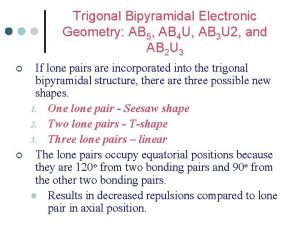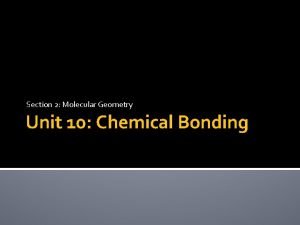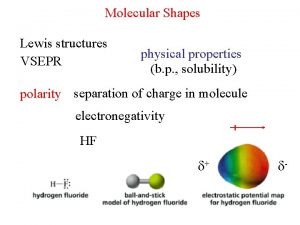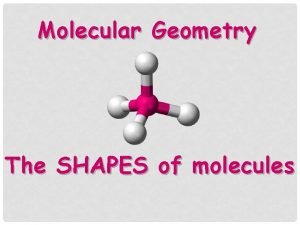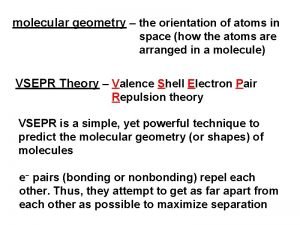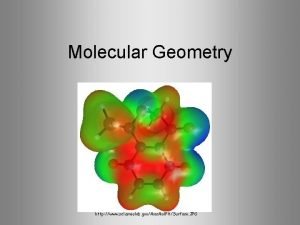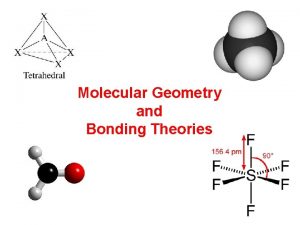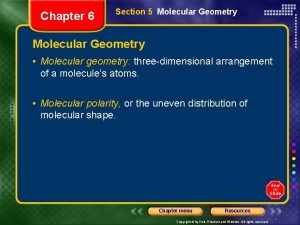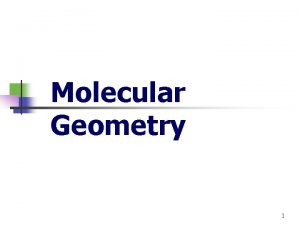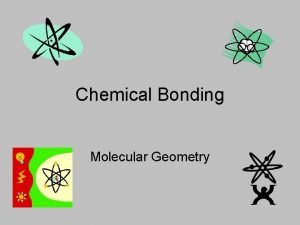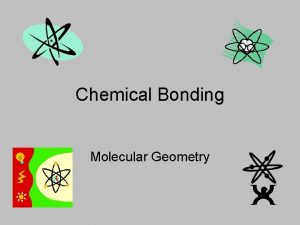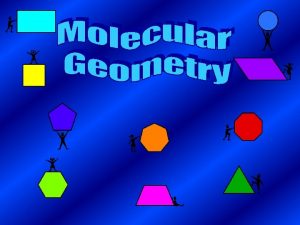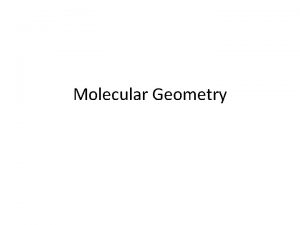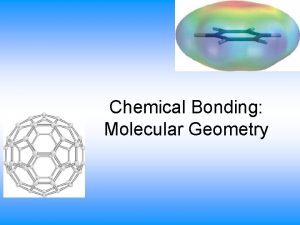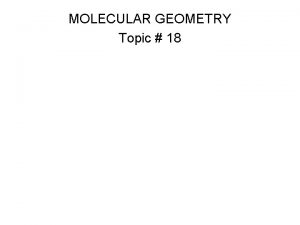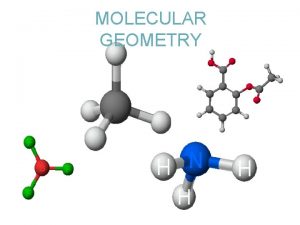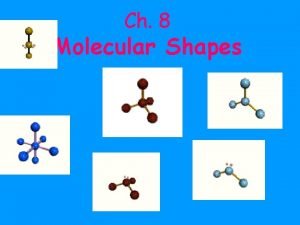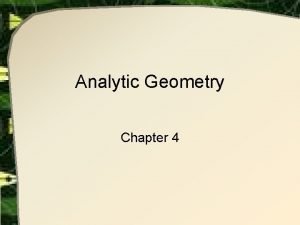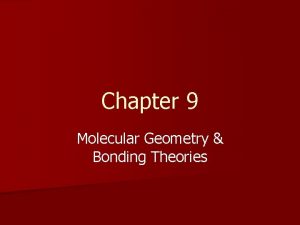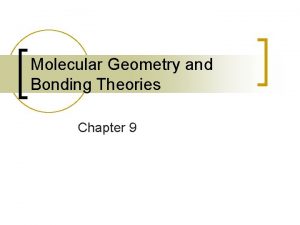Chapter 6 Section 5 Molecular Geometry Molecular Geometry

















- Slides: 17

Chapter 6 Section 5 Molecular Geometry

Molecular Geometry Properties of molecules also depend on their shape Polarity of each bond and geometry on molecule determines the molecular polarity Uneven distribution of charge Affects how molecule interact with each other

Molecular geometry Molecular Geometry— 3 -D arrangement of the atoms in a molecule Chemical formulas tell very little about the geometry Chemists have two possible systems to figure it out

VSEPR Theory Valence-Shell, Electron-Pair Repulsion between the sets of valence-level electrons surrounding an atom causes these sets to be oriented as FAR apart as possible Translation: electrons don’t want to be near each other, so they get as far apart as possible w/out leaving the atom

VSEPR Theory Putting it to use Best way to do this is to use this chart to predict shapes based on the Lewis dot diagram Go to page 200 Look at the chart Notice that there are 8 shapes possible The Lewis structure on the right will be the best help for you

Hydrogen Two matching atoms Get electrons farthest apart by being linear academic. brooklyn. cuny. edu

Boron trifluoride Remember that boron is the exception to the octet rule. It forms compounds with only 6 valence electrons. The angle between the fluorine atoms is 120 degrees. This molecule is flat. chemeddl. org

VSEPR Theory and Molecular Geometry This chart is available in your book on page 200. Page 200 or a copy of it will be available for you to use on your test. This image is from faculty. sdmiramar. edu

Example 10 Use VSEPR theory to predict the molecular geometry of boron trichloride, BCl 3 http: //en. wikipedia. org/wiki/Boron _trichloride

Example 11 Use VSEPR theory to predict the molecular geometry of the following molecules CCl 4 HCN Si. Br 4

Example 12 Use VSEPR theory to predict the shape of a molecule of carbon dioxide, CO 2. http: //en. wikipedia. org/wiki/Carbon _dioxide

Hybridization VSEPR theory explains geometry Doesn’t explain how geometry and orbitals are related Hybridization model—explains which orbitals are used to form covalent bonds Hybridization—mixing of two or more atomic orbitals of similar energies on the same atom to produce new hybrid orbitals or equal energies

Hybridization of Methane Take methane CH 4 C has two electrons in the 2 s orbital and 2 in the 2 p orbital They combine to form an sp 3 orbital that has four electrons in it Hybrid orbitals are orbitals of equal energy produced by the combination of two or more orbitals on the same atom

Hybridization Final details The number equals the number that have combined See the chart on page 203 for the shape of the orbitals

Intermolecular forces Force of attraction between molecules Vary in strength Generally weaker than bonds in the atoms Dipole—created by equal but opposite charges on an atoms that are separated by a short distance Represented by an arrow over the compound

Hydrogen Bonding Intermolecular forces in which a hydrogen atom that is bonded to a highly electronegative atoms is attracted to an unshared pair of electrons of an electronegative atom in a nearby molecule Hydrogen bonding only happens when H is bonded to F, O, or N

London Dispersion Forces Intermolecular attractions resulting from the constant motion of electrons and the creation of instantaneous dipoles Act between all atoms and molecules Increase with increasing atomic or molar mass
 Theory of structures
Theory of structures 4 electron domains 2 lone pairs
4 electron domains 2 lone pairs Molecular geometry and bonding theories
Molecular geometry and bonding theories Chapter 12 section 1 molecular genetics answer key
Chapter 12 section 1 molecular genetics answer key Chapter 12 section 1 molecular genetics answer key
Chapter 12 section 1 molecular genetics answer key Physical state of covalent compounds
Physical state of covalent compounds Ionic covalent metallic
Ionic covalent metallic Giant molecular structure vs simple molecular structure
Giant molecular structure vs simple molecular structure What does vsepr theory predict
What does vsepr theory predict Chem shapes
Chem shapes Pf3 number of vsepr electron groups
Pf3 number of vsepr electron groups Sf5cl lewis structure
Sf5cl lewis structure Molecular geometry chart
Molecular geometry chart Bp lewis structure
Bp lewis structure Vsepr shapes
Vsepr shapes Non polar molecule
Non polar molecule Molecular geometry of no3-
Molecular geometry of no3- Molecular geometry and bonding theories
Molecular geometry and bonding theories











